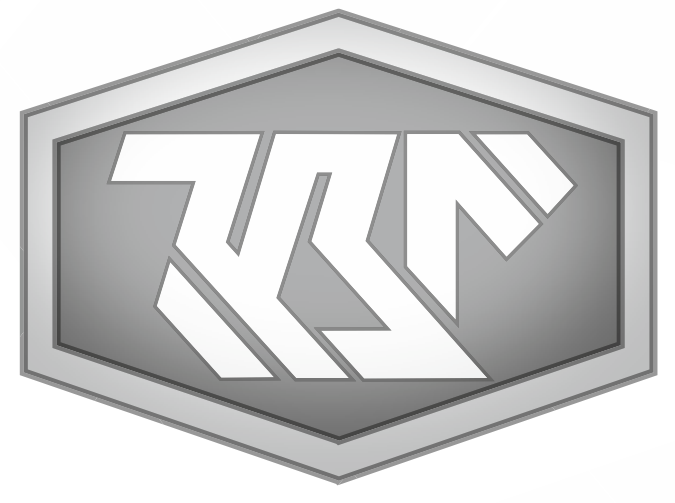19 August 2019
Lift and forgive
Magazine "4X4 All-Wheel Drive"
Text and photo: Andrey Farobin
There are legends about the GAZ-66’s ability to conquer off-road conditions, which are not too far from the truth. The GAE-3308 "Sadko" that replaced it has a less favorable weight distribution along the axles, but the truck is also far from a miss. as it turned out, it is possible to raise the already high level of cross-country ability of these vehicles to an unattainable level.
The modified car was named "Siver". This is in tune with the North, where such technology is most in demand. However, you never know where we have places where roads... um, how can I put it mildly? - Well, you understand what I'm getting at. Instead of building them, at least some of them, we come up with cars that don’t need roads or almost don’t need them. And our open spaces oblige...
Snow and swamp-going vehicles appeared on low-pressure tires. In certain cases, it is difficult for them to find a worthy replacement - in the same swamps or virgin snow, but these cars do not drive well on muddy clay tracks and logging clearings here. I was personally convinced of this during a trip along the “dead road” (see PP4x4 No. 12 for 2011). Once upon a time, a friend and I found ourselves in the same forestry on an all-terrain vehicle of this type. The verdict of the locals was unequivocal: “If you don’t go far, you’ll blow all your tires.” But people drive and suffer: what remains is that standard wheeled vehicles no longer work here, and caterpillar tracks are a different story altogether. At the All-Terrain Vehicles Plant, near Nizhny Novgorod, in collaboration with Spetstekh LLC, they produce in small batches something larger than the GAZ-66 or Sadko, just to replace all-terrain vehicles in places where they can be used, but not necessary .
Stilts for "SADKO"
The idea is not original: increase ground clearance and, accordingly, install huge wheels. Both of these circumstances dramatically affect cross-country ability. Final drives of our own design were mounted on standard drive axles. Since the gears are externally engaged, the mechanism requires three shafts - otherwise the car will move backwards rather than forwards. The total gear ratio of the additional gear is 2.06. The sample I tested had TyRex Agro tires with a size of 21.3R24 (there are IYAV-79 tires of the same size, but diagonal). The outer diameter of the wheels is 1400 mm, which is 460 mm more than the standard parameter. As a result, you can walk under the car on your haunches - the ground clearance is 650 mm. Let me remind you: in the factory version of the Sadko, like the GAZ-66, it is 315 mm. Of course, in addition to increasing ground clearance, final drives work to increase torque on the wheels, because otherwise the standard engine and transmission will not turn them over.
Since the chassis of the discontinued GAZ-66 and the current Sadko are almost identical, a set of gearboxes and wheels (plus the original rear axle shafts and outer parts of the front CV joints, as well as brackets for mounting the gearboxes) is suitable for installation on both trucks. They buy the first one more actively. The driver and passenger cannot be envied here: neither ease of operation nor comfort. A double cab option is also impossible, but there is a circumstance for which everything is forgiven. The mentioned advantage in weight distribution has nothing to do with it - everything is much more prosaic: such a car is cheaper, since the “shishiga” is taken second-hand, and the “Sadko” is brand new, from the factory assembly line. The price tags are noticeably different. True, the condition of the cars is different, to put it mildly. The GAZ-66 still needs to be brought to life before conversion, but working magic on a new car is much more pleasant. Although surprises are possible here too: on the Sadko that I rode, only the test driver was able to connect the front axle... with his foot from the back seat. So not everything is so simple. But "Sadko" comes in the factory version with an MMZ D-245 diesel engine, which is much better than the 3M3-513 gasoline engine. Often, along the way, they order the installation of a diesel engine on the “shishiga”, so as not to experience problems due to the lack of torque on the huge wheels.
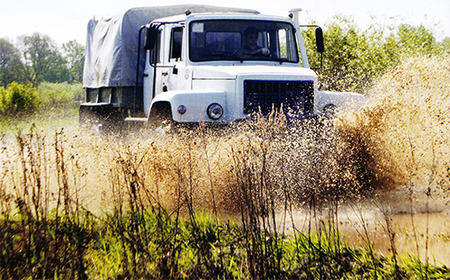
No spare tire needed
Впрочем, совсем не обязательно покупать переоборудованный автомобиль целиком - можно установить комплект из колес и редукторов на свой проверенный грузовик самостоятельно, и такой вариант по душе многим заказчикам. Не уазик, конечно, масштабы деталей несколько иные, без легких средств механизации не обойтись. Например, редуктор весит около 80 кг, а колесо в сборе с диском - под 200. (Запаска, кстати, из-за своих размеров и веса не предусмотрена вовсе: есть подкачка, реально добраться до базы и на спущенной шине - резину с многослойным кордом прикончить не так-то просто). Машина становится тяжелее - падает полезная нагрузка, которую она способна нести? Все так, но подобный транспорт редко используют для перевозки серьезных грузов, Наилучшим спросом пользуется не грузовик с большой платформой и двухместной кабиной, а гибрид со сдвоенной пятиместной кабиной и кургузым кузовком сзади. Главное самим с легким экспедиционным скарбом доехать туда, куда ни обычная "шишига", ни трехосный "Урал" не доберутся. Такая задача стоит и перед охотниками (частниками или промысловиками), и перед геологоразведчиками, и перед многими другими, кто в силу различных обстоятельств вынужден перемещаться по неосвоенным просторам нашей страны.
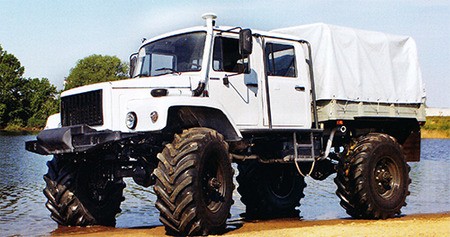
Дорожный просвет в 650 мм - это серьезная заявка на сверхпроходимость
Из первых уст
К сожалению, по-настоящему проверить ходовые качества "Сивера" мне не довелось. Окрестные низины просохли, а ехать куда-то далеко не было возможности. Да это и долгая история, поскольку скорость у машины невелика - длинные перегоны не для нее. Мы лишь несколько раз пересекли волжскую старицу, не испытав при этом ни малейших затруднений. Доверимся словам водителя Андрея Кравченко, утверждающего, что стандартная "шишига" на берег вряд ли бы смогла выбраться самостоятельно.
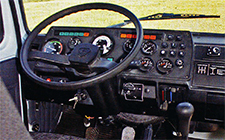 Штатный спидометр не годится: скорость упала раза в два, поэтому и шкала заклеена
Штатный спидометр не годится: скорость упала раза в два, поэтому и шкала заклеена
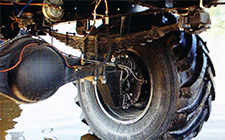 Вся соль конструкции - в бортовых редукторах
Вся соль конструкции - в бортовых редукторах
Послушаем тех, кто проверил машину более основательно, чем мы. Вот, например, что поведал Валерий Лаврентьев из города Котлас (юго-восток Архангельской обл.), директор лесохозяйственного предприятия "ОрбитаЛесСервис": "Мы используем "Сивер" для доставки бригад в отдаленные лесные районы. Или до момента начала лесозаготовок, или после них - в обоих случаях дорог практически нет. ТРЭКОЛ не годится, главным образом, из-за того, что колеса низкого давления не приспособлены для езды по лесу - проколоть их очень легко. Когда с дырой в шине вы оказываетесь в полусотне километров от базы, в совершенной глуши, то это просто опасно, поскольку помощи ждать неоткуда. Надежность машин с узлами от уазика, на которые тут приходятся совершенно иные нагрузки, тоже оставляет желать лучшего. Гусеничные машины крепки и проходимы, но необходим транспорт для их переброски из одного района работы в другой. Ездить приходится и по нормальным твердым дорогам, и на гусеницах это сущее мучение.
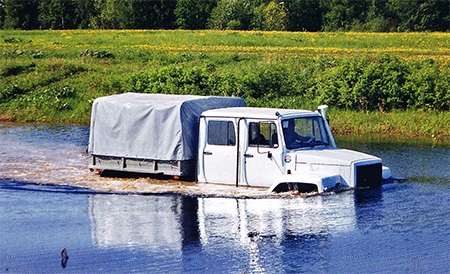
It's time to install navigation lights
So we decided to try to operate an ultra-high cross-country vehicle, and not a snow and swamp-going vehicle with a narrow scope of application. We chose a car based on the GAZ-66: trust in the well-deserved army truck is higher than in the relatively recently baked Sadko. There are no complaints about the modernized transmission - it works without breakdowns. On very soft soils, the Siver cuts the ruts well - this is a minus. But on peat bogs and waterlogged soils, it is much better than TREKOL: the tires have good grip on the ground and do not slip. Now we don’t pay attention to snags and sharp stumps. We have now ordered the third Siver.
| "SIVER" 3BM-39081 | |
|---|---|
| Engine | |
| Type | Inline 4-cylinder turbodiesel |
| Working volume, cm3 | 4/50 |
| Max, power, l. With. at rpm | 122/2400 |
| Max, torque, Nm at rpm | 423/1500 |
| Transmission | |
| type of drive | Pluggable full |
| checkpoint | GAZ-3308, 5-speed. |
| Suspension | |
| Front/rear | Dependent/dependent |
| Brakes | |
| Front/rear | Drum/drum |
| Dynamic characteristics | |
| Maximum speed, km/h | 55 |
| Geometric characteristics | |
| Length, width, height, mm | 3250/2850/3100 |
| Wheelbase, mm | 3770 |
| Front/rear track, mm | 2150/2150 |
| Ground clearance, mm | 650 |
| Other | |
| Maximum rise, degrees. | 35 |
| Maximum ford depth, m | 1.5 |
| Total weight, kg | 7000 |
| Tire size | 21.3-24 |

These final words from Valery clearly show that the car turned out well, people like it and are in demand.
For the Siver, this is, of course, not off-road; the car is capable of going on a much deeper rut - we simply couldn’t find one.
